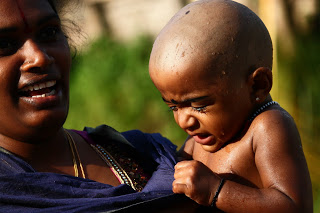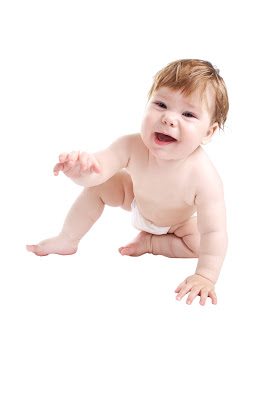As a mom to newborn E. (my now 13 year-old son), I was ripe with the maternal love hormones prolactin and oxytocin. It’s one of the reasons new parents seem a bit dopey. Biochemicals like oxytocin, prolactin, and vasopressin, in particular, make maternal and paternal bonding possible. We are all, it turns out, wired for connection. In those early days with E. it didn’t really matter to me that there were specific centers of my brain, and highly elaborate neural mechanisms activated to ensure my maternal love, recognition of my baby, and the kind of protectiveness that promotes secure attachment. I was either blissfully oblivious or too darn tired to notice. Read on for some “good news!”
I now know that not only was it important that I received loving care and touch myself as an infant—particularly in the first six months of life—but having a secure attachment with my husband also helped immensely in coaxing him into the intense dyad that E. and I became. Those extended invitations for my husband to co-parent with me not only, it turns out, helped to ensure E.’s survival through their secure attachment—but has also proved to be an essential primary attachment and positive model of manhood for E. We had both already established our ability to receive and give love, and here in our arms was the perfect opportunity to put it all into practice.
The good news: As long as we got some good stuff during our first six months of life, chances are higher that we can learn to become good parents. I also want to be clear that though research shows a critical period of development in the first six months of life; our ability to learn to form attachments throughout the lifespan is by no means limited to that critical period, nor is it limited in the type of primary attachment figure necessary. Does it need to be said that this is inclusive of any type of loving parental relationship surrounding an infant, whether straight or gay, single or two-parent, married or not? Infants aren’t as discerning as our lawmakers—they just want our love!
Let’s review what attachment means. Essentially, it is the affective, cognitive, and behavioral relationship between typically a parent (or other loving caregiver) and a child that results in feelings of closeness, empathy, and understanding.
Also, while reading this post I’d like you to reassure you! I’d like you to think of attachment as a spectrum, on one end is the abandoned orphan who never had the chance to form a secure attachment with a loving, consistent caregiver. We all sadly learned about these orphans in news footage during the early 1990’s when Ceauşescu’s regime collapsed in Romania. Many of these orphans were later adopted into brave families throughout the world and have gone on to thrive because of their adoptive parents’ consistent, loving care. The orphans who were never held, barely fed, and exposed to a multitude of infectious diseases in their first six months rarely recovered a capacity to thrive developmentally, intellectually, and even more importantly for survival, interpersonally. In some cases, the neurological damage was permanent. That’s how extreme the depravity needs to be for a human being to cease learning to form secure attachments.
On the other end of the spectrum, nestled comfortably behind the proverbial picket fence, is the mother-father-infant triad with plenty of love, time, financial resources, community support, and health insurance—as if there is one perfect way to secure attachment learning in a child. Which there isn’t! Between these two extremes, we all find ourselves cobbling together our resources, knowledge, genetics and inborn temperament, family configuration, circumstances of our lives, and personal histories, spinning the wheel of life, and landing where we may on the spectrum with our child. It’s all just about learning how and continuing to form loving connections, which often takes emotional courage! We will be discussing throughout upcoming posts ways to promote and ensure parent-child secure attachment and sharing some inspiring examples from around the world!
Let’s be clear: Across the spectrum of attachment the vast majority of us continue to prove our remarkable resilience and neuroplasticity! Neuroplasticity meaning: the brain’s natural ability to form new connections in order to compensate for injury or changes in one’s environment.
Again, I want to reiterate that forming loving, secure attachments is vital for the survival of our species. Primary attachments, usually parents, help kids develop the kind of prosocial skills associated with social courage. (So do secondary attachments like those with our beloved aunties, uncles, grandparents, siblings, step-parents, foster parents, teachers, and other loving guides along the journey…more about these relationships in later posts). Social skills including:
- self-calming skills
- being aware of one’s own emotions
- recognizing the feelings of others
- being compassionate
- impulse control
- ability to make eye contact
- sharing and turn-taking
Think of it like this: unless you experienced being cared about, why would you run into a burning building to show your altruistic care for another? Unless you learned, through the loving touch of another human being, to be calm during stress—how could you be compassionate and sensitive enough to soothe your own screaming child? Unless you have a strong bond with your child, how will you be able to encourage them to be brave when the going gets tough?
In my personal, professional, and parenting experience…securely attached kids are more confident to explore the world on their own, care more about themselves and others (including us as their parents), and are more apt to resist peer pressure and have the courage to take prudent risks in life. Contrary to many parents’ fears about spoiling their child, or raising a velcro-kid who grows into an adult-child who never wants to leave home; infused with our love, support, and courage-coaching, securely attached children grow into confident, caring, capable, and independent adolescents. But don’t just believe my word for it, here’s a list of the payoffs of raising securely attached kids.
When we ensure secure attachment between ourselves and our children through loving them, we do not spawn cling-ons. Being a secure attachment relationship for your child also doesn’t mean you need to be at home full-time, never let them out of your sight, or never lose your patience. It looks more like trusting your gut, loving your child, and doing your level best as a parent whatever the circumstances of your life. There are specific steps to forming secure attachments with children which I will be writing at-length about in this parenting blog.
As a parenting coach, I have the unique opportunity to help parents ensure that they are engaging in the kinds of behaviors, stimulating the kinds of neurochemicals necessary, and thinking the kinds of thoughts that trigger the hormonal chain reactions involved in forming secure attachments. More about the chemical soup we call love in my upcoming posts! If you have questions about attachment and/or an interest in parent-coaching, don’t hesitate to post a comment or contact me.

Here’s a sampler of what happens in the first year, in terms of infancy attachment. Read over the list as a way to understand infant development as it relates to bonding and the formation of secure attachments. I have shamelessly cut and paste from an informative and hopeful article by the son of the brains behind attachment theory, Sir Richard Bowlby (2007):
0 to 3 Months – A baby’s born with a number of functioning behavioral systems that will form the building blocks of later attachment behavior such as crying, clinging, looking, and sucking; and then a few weeks later they’re smiling and babbling, as well. From birth, babies have good hearing and sense of smell, which is how they discriminate one person from another, and they respond more favorably to a human voice, to a human face, and to human touch than to other such stimuli.
Newborn babies have a natural propensity to prefer and seek out stimuli that are familiar to them; and they may develop a preference for a familiar person to care for them early on. However, for the first two, or even three, months the infant has not developed proper attachment behavior and his attempts at social interaction are very primitive.
3 to 7 Months – After about three months, babies begin to differentiate between the people around them and they become selective about who they “socialize” with most. Mary Ainsworth writes: “One feature of attachment behavior that struck me especially was the extent to which the infant himself takes the initiative in seeking an interaction. At least from two [or more often three] months of age onwards, and increasingly through the first year of life, these infants were not so much passive recipients, as active in seeking interaction.”
This period from about three months to seven months is when the babies work out who’s who in their lives and increasingly select one person. It’s during this phase that most infants are in a high state of sensitivity for developing attachment behavior toward a “mother figure,” and her lively and sensitive response to the baby’s signals and approaches for interaction will be very important.
7 to 12 Months – When they’re six or seven months old, the infants become increasingly discriminating in the way they treat people and have a repertoire of responses including following a departing mother figure, greeting her on her return, and using her as a base from which to explore. Although the rather indiscriminate friendly response to everyone else diminishes, certain people are selected to become secondary attachment figures but not others. Although most babies show the beginnings of attachment behavior at six or seven months, the start may be delayed until after the first birthday, especially in infants who have little contact with their main attachment figure.
Watch for Don Haln’s (2010) heartbreaking and inspiring documentary about Romanian orphans: http://handheldthemovie.com/
Share your tales of courage from parenthood! We want to hear from you!
Sources:
Beckett, C., Maughan, B., Rutter, M., Castle, J., Colvert, E., Groothues, C., Kreppner, J., & Stevens, S.,
O’Connor, T., Sonuga-Barke, E. (2006). Do the effects of early severe deprivation on cognition
persist into early adolescence? Findings from the English and Romanian adoptees study. Child
Development, 77, (3), 696 – 711.
Bowlby, R. (2007). The secondary attachment: A look at Bowlby’s theory. The Journal of API. http://www.psych.ndsu.nodak.edu/hilmert/Classes/Psyc787/Week9/Taylor_2000.pdf
Dewar, G. (2008). The science of attachment parenting. Parenting Science. http://www.parentingscience.com/attachment-parenting.html
Noriuchi, M., Kikuchi, Y. & Senoo, A. (2008). The functional neuroanatomy of maternal love: Mother’s response to infant’s attachment behaviors. Biological Psychiatry, 63, 415–423.
Palmer, L. (2002). Bonding matters: The chemistry of attachment. Attachment Parenting International News, 5, (2), 1-4. http://www.newbornbreath.com/downloads/Handouts/Chemistry%20of%20Attachment.pdf
Riley, D., San Juan, R., Klinker, J., & Ramminger, A. (2008). Social & emotional development: Connecting science and practice in early childhood settings. St. Paul, MN: Redleaf Press



Interesting perspective